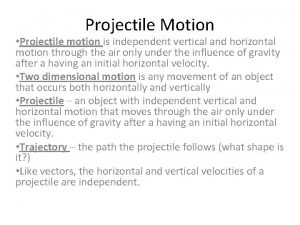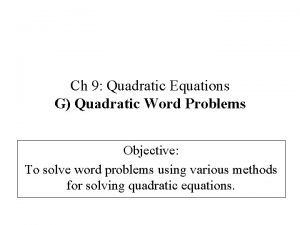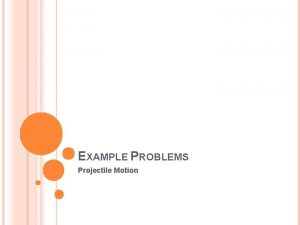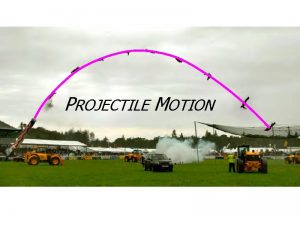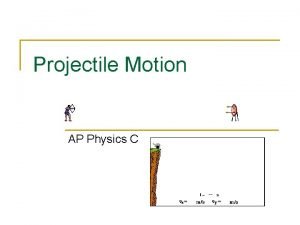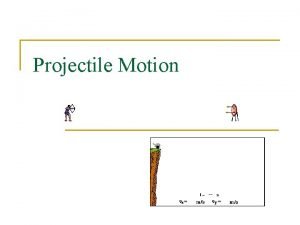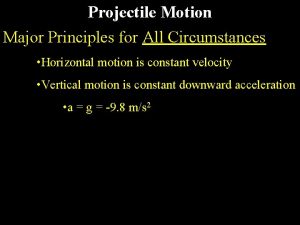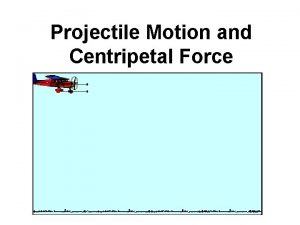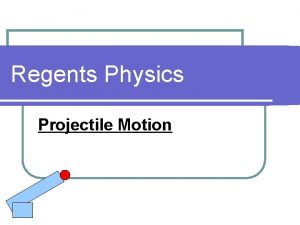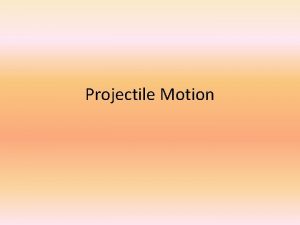Projectile Motion What is a projectile A projectile












- Slides: 12

Projectile Motion

What is a projectile? • A projectile is any object that is cast, fired, flung, heaved, hurled, pitched, tossed, or thrown. (This is an informal definition. ) The path of a projectile is called its trajectory.

Some examples of projectiles include … a baseball that has been pitched, batted, or thrown a bullet the instant it exits the barrel of a gun or rifle a bus driven off an uncompleted bridge a moving airplane in the air with its engines and wings disabled • a runner in mid stride (since they momentarily lose contact with the ground) • the space shuttle or any other spacecraft after main engine cut off (MECO) • •

“Acted on only by gravity. ” • The force of primary importance acting on a projectile is gravity. This is not to say that other forces do not exist, just that their effect is minimal in comparison.

What is NOT a projectile? • A tossed helium-filled balloon is not normally considered a projectile as the drag and buoyant forces on it are as significant as the weight. Helium-filled balloons can't be thrown long distances and don't normally fall. In contrast, a crashing airplane would be considered a projectile. Even though the drag and buoyant forces acting on it are much greater in absolute terms than they are on the balloon, gravity is what really drives a crashing airplane.

• A projectile is any object with an initial nonzero, horizontal velocity whose acceleration is due to gravity alone.

• An object ceases to be a projectile once any real effect is made to change its trajectory (for example thrusters on a rocket). The trajectory of a projectile is thus entirely determined the moment it satisfies the definition of a projectile.

• Airplanes, guided missiles, and rocketpropelled spacecraft are sometimes also said to follow a trajectory. Since these devices are acted upon by the lift of wings and the thrust of engines in addition to the force of gravity, they are not really projectiles. To get around this dilemma, it is common to use the term ballistic trajectory when dealing with projectiles.

Satellites • Technically, such an object would still be a general projectile, since gravity is the primary source of its acceleration, but somehow this doesn't seem right. Objects traveling through what we call "outer space" hardly seem like projectiles any more. They seem like they reside more in the realm of celestial mechanics than terrestrial mechanics.

New Horizons • http: //pluto. jhuapl. edu/

Every projectile problem is essentially two one-dimensional motion problems … equation horizontal vertical acceleration ax =0 ay = −g velocity-time vx = v 0 x vfy = v 0 y − gt displacement-time Δx = v 0 xt Δy = v 0 yt − ½gt 2 velocity-displacement vfy 2 = v 0 y 2 − 2 g(Δy)

 Range in physics formula
Range in physics formula Projectile motion animation
Projectile motion animation Javelin throw way in achieving projectile motion
Javelin throw way in achieving projectile motion Projectile motion
Projectile motion Word problems on quadratic equations
Word problems on quadratic equations Projectile motion example problems
Projectile motion example problems Projectile motion examples
Projectile motion examples What is c
What is c Examples of projectile motion in volleyball
Examples of projectile motion in volleyball Projectile motion
Projectile motion Formula projectile motion
Formula projectile motion Table 2.1.3 horizontal motion description
Table 2.1.3 horizontal motion description Vy=voy+gt
Vy=voy+gt



